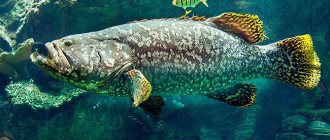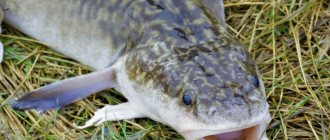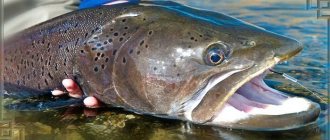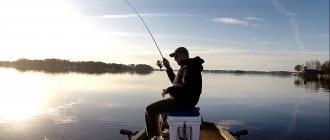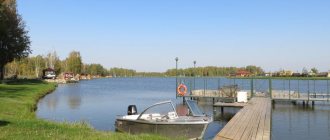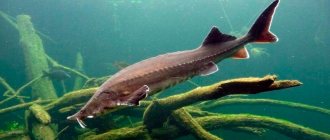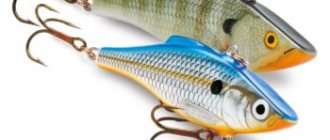What does bream look like: description and varieties
Characteristic features that allow one to accurately identify a bream are a massive, laterally flattened body (its height is equal to a third of the total length), a disproportionately small head with small eyes, and a protruding mouth like a tube. The description of the bream can be supplemented with one more feature: the lower blade of its caudal fin is larger and longer than the upper one.
The average lifespan of bream is 10 years; under favorable conditions, some individuals can live up to 15 years or more. The species is a fast-growing fish: at the age of 10 years, their body length reaches 70-80 cm, and their weight is 4-5 kg.
The maximum weight of bream and its size largely depend on the region where it lives, the caloric content and amount of food. In the southern and central regions, the annual increase ranges from 300 to 500 grams. In cold climates, weight increases one and a half to two times slower.
Bream is suitable for artificial breeding, and can be grown in a reservoir either independently or together with other species of fish.
What family does bream belong to?
Breams that inhabit fresh water bodies belong to the carp family and the order Cypriniformes. Sea breams, which got their name for a certain external resemblance to freshwater inhabitants, are representatives of the order Perciformes.
Types of bream
River or lake bream ( Abramis brama ) is the only representative of the bream genus. Fish living in different bodies of water may differ slightly in the color of their scales: from silver to golden and golden-brown. In some sources you can find mention of East Siberian bream. This species of bream lives in the reservoirs of the Far East.
There are two subspecies of fish:
White bream
- White Amur bream . In appearance it is similar to the inhabitants of European reservoirs. The main difference is the darker color of the back: it can have a greenish or brown tint.
- Black bream . It has dark, almost black scales, the abdomen and the lower part of the sides are lighter.
Black bream
Quite often you can find names of fish that indicate where they live. Thus, bream caught in the Tsimlyansk Reservoir on the Don is called Tsimlyansk or Don bream, and bream caught in the Iriklinsky Reservoir is called Iriklinsky bream. Such names are given solely to emphasize the size and taste of the fish: due to the purity of the water and the presence of a sufficient food supply, adult bream grown in the reservoir has very tasty juicy meat.
RAM
What is bream fish?
The bream has a rounded body shape with a significant (relative to its size) distance between the upper and lower points on the back and belly, respectively. The height of the fish is 1/3 of the length. The head is shaped like the body and is small in size, like the mouth. The latter goes into a tube, the length of which can change at the request of the fish itself.
The adult has a brown or gray back, yellowish belly and golden flanks. Young individuals have a silvery tint. Bream can reach 82 cm in length and 6 kg in weight. Fish live long - sometimes more than 20 years.
What is the difference between bream and white bream?
Many people mistakenly believe that bream and bream are different fish. In ichthyology there is only one common name for the species - bream. All other names are slang and are used by fishermen to divide trophies by weight and size. Thus, small individuals that have not reached sexual maturity are called breams, and adult females and males are called bream, chebak or keel.
Bream and white bream
The external difference between bream and white bream is as follows:
- The scales of young fish are light; adult fish have a dark silver or dark golden hue.
- Breams are more rounded, and breams are flatter.
Typically, breams include fish weighing up to 1 kg, and breams - 1 kg and above. This division is conditional, since the size of individuals depends on the climate and living conditions: in the northern regions, the growth of young animals occurs slowly, so bream ripe for reproduction can weigh only 500-600 grams.
The biggest bream
Bream is a fish of the carp family that is very common in many seas, rivers, lakes and reservoirs of the world. According to reliable sources, its dimensions are: body length - from 70 to 100 cm, maximum weight - 6 kg, and life expectancy (if you're lucky) - 23 years, but in nature there are always exceptions, what are the actual dimensions of the largest caught bream? It is also interesting to find out in which bodies of water the largest bream in the world are found.
Bream lives in reservoirs with warm water, so it is impossible to catch it in cold Siberian rivers; it is not found in fast-flowing mountain rivers with cold water. These fish group in large schools, prefer deep places in reservoirs, feed on plankton and those microorganisms that live in the bottom soil. With age, bream not only increases in size, but also changes the color of its scales: in young individuals it is light gray, and bream older than a year have a brownish-yellow or bronze color.
It is not uncommon to catch a bream weighing up to 3 kg, but 4–5 kg and above are already trophy specimens. If there are suitable conditions in the reservoir, then bream can grow to enormous sizes, and its weight can be 8 - 10 kg. Of course, it’s no secret that fishermen’s stories can be too exaggerated, and over time turn into mythical, but if we turn to reliable information about the actual weight of the giants caught, then history says that in 1912 in Finland, a record weight of bream was recorded on Lake Vesijärve , which amounted to 11.6 kg.
But it turns out that this is not the limit of the possible, since there is evidence that on the territory of Russia (Vitebsk province) in Lake Virovlya they caught individuals that reached a weight of 16 kg! These are the largest breams in the world. Large bream can be caught in the lower reaches of rivers such as the Dnieper, Don, Oka, Samara, and they are also found in the Volga.
To catch a trophy bream, an avid fisherman needs to make a lot of effort, visiting more than one body of water, and be attentive to his own observations and what others say about their fishing achievements.
In order for a bream to grow to a size of over 3 kg, it needs certain conditions: a lot of water, food, a shallow depth of the reservoir and a sufficient number of fish - predators living in it. It is the predators that reduce the number of fry and young bream (they are not scary for adults, unless it is a bottom pike), and for the “old people” there remains a lot of plant and meat food, as well as enough space for growth.
The difference between bream and silver bream
Novice fishermen often mistake an adult silver bream for white bream. It can usually be distinguished by the shade of its fins, the ends of which are colored red or pink. However, in water bodies with an abundance of predators, the silver bream is forced to become less noticeable, as a result of which the fins darken and the difference is practically invisible.
In this case, you should focus on the following physiological differences:
- The body of the silver bream is very flat, as if compressed from the sides.
- The eyes are significantly larger in comparison to the size of the head.
- Both feathers of the caudal fin are of equal length.
- The scales of the silver bream are larger, so the number of rows from the midline to the highest point of the body is only 10-11, and not 14-15, like the bream.
Bream and silver bream
Bream spawning
Readiness for reproduction occurs in males and females at the age of 3-4 years. To lay eggs, bream choose shallow waters with a lot of vegetation. The optimal temperature for spawning is +18-20 degrees. In the central regions, bream spawning begins in mid-April, in the northern regions - in early May. Under unfavorable weather conditions, bream begins to spawn 7-10 days later. Reproduction takes place in several stages. Larger individuals spawn first. The spawning site can be determined by its characteristic splashes: males and females jump out of the water and hit the surface with force, creating clapping sounds.
The physiological fertility of a female bream ranges from 10,000 to 150,000 eggs during the spawning period. Fertilized eggs are covered with a secretion, with the help of which they are attached to the leaves and branches of plants. The time for the eggs to ripen depends on the water temperature. In well-warmed reservoirs, fry appear within 3-4 days. For the first few days they feed on the contents of the yolk and remain attached to the plant.
PELENGAS
Description
This type of fish cannot be confused with others. The main distinguishing feature of bream is its flat body and arched back. No representative of fish living in freshwater bodies has such a tall body. There may only be a white-eye, but it has a small weight, while the weight of an adult bream is from 2.5 to 3 kg, the length of a large bream reaches 45 cm. The life span is up to 20 years, but as a rule they live less.
The body and fins of the bream are gray in color, the belly is closer to white. The fins are pinkish in color with a red tint. In each region, the color may differ from the standards; age has a great influence on the color of fish scales. The older the bream, the darker it is.
Bream is a bottom-dwelling fish. The main food is a variety of larvae, crustaceans and bloodworms. The peculiar structure of the mouth of a representative of cyprinids allows it to fold its lips into a long tube, which makes it possible to pull food out of the silt. To do this, the fish takes water into its mouth and blows it forcefully onto the mud, thereby freeing access to the larvae.
What does bream eat?
The special structure of the mouth allows the bream to push its lips forward in the form of a trunk. The fish becomes upright, with its head down, moves close to the bottom and sucks up the silt. Small particles suitable for nutrition are retained by the gill rakers.
What does bream eat?
The diet of young animals and adults includes zooplankton, invertebrates, crustaceans, eggs of other fish and algae particles.
How to catch bream
When choosing a place and time for fishing, the following behavior and habits should be taken into account:
- Breams are cautious and timid. The probability of catching a trophy increases during the feeding period, which occurs during the period from leaving the winter quarters to spawning and after the end of spawning.
- Active biting continues until the end of autumn, when bream gathers in numerous schools to look for a parking spot for the winter months.
- The habitats of bream on the river can be determined by the floating air bubbles: when, during feeding, the fish lifts silt from the bottom in search of food, swamp gas is released and rises to the surface.
- The fish continue to feed in winter. Typically, bream overwinters in the deepest places with an uneven bottom covered with silt and stones.
- The flocks go out for feeding with a certain cyclicity. If an active bite was observed at a selected location at some time, there is a high probability that it will be repeated in the same place and at that time of day throughout the entire season.
To catch bream, use float or bottom fishing rods with a strong and inconspicuous rod. The optimal thickness of the fishing line is 0.15-0.20 mm. As bait, you can use animals (worms, maggots, bloodworms), plants (barley, corn, semolina) or mixed baits. Before starting fishing, the area should be well fed. Preliminary feeding for several days will help increase the likelihood of catching bream. For feeding, a mixture of cereals, millet and peas is prepared. To enhance the smell, add a small amount of breadcrumbs, sunflower cake or crushed oilseeds to the porridge. Experienced fishermen add skimmed milk powder to the mixture, which, when dissolved in water, forms a cloud that attracts bream. Various flavorings can be used as an additive. Bream has a very good sense of smell, so any unnatural smells can scare the school away from the feeding area. Add sand or clay to the prepared mixture for ballast.
You can catch bream from the shore or boat. The most active biting is observed at night and early in the morning. The bite has a pronounced character: the bream grabs the bait lying on the bottom and lifts it from the bottom, it is at this moment that the float lies on its side, which is a signal to hook. When landing large specimens, you need to lift them above the surface of the water and let them take a breath of air. This will weaken the resistance and allow you to drag the long-awaited trophy to the shore.
Features of life
It is difficult to say the maximum size to which bream grows; schools in summer and winter often include both large representatives and small fish.
The peculiarities of life activity encourage this representative of cyprinids to cluster in groups, but the number of individuals depends on many indicators:
- in summer, ichthyans from the south travel in small groups; for permanent residence they choose places with a small amount of vegetation, but the bottom topography can be either sandy or clayey; they often go out to feed at night and in the early morning hours;
- northerners behave a little differently, they will not always be in quiet backwaters and leisurely look for food; often representatives of cyprinids in northern reservoirs go to areas with strong currents, sometimes even to the fairway.
With a decrease in air and water temperatures, individuals from almost the entire water area gather together and go to deep places for wintering, they are also called wintering pits. Here the bream has a wide variety of sizes.
The nutritional value
White bream meat contains many useful substances: polyunsaturated fatty acids, potassium, magnesium, phosphoric acid, vitamins A, D, E, PP, B1 and B2. The protein contained in fish is well absorbed, providing the body with many essential amino acids. Calorie content of meat - 105 kcal per 100 g.
Smoked bream
In addition to its high nutritional value, bream has excellent taste. The fish meat is soft, tender, and has a slight sweetish taste. For preparing dishes, it is recommended to use large adult fish, since small bream, which have a slightly lower fat content, turn out dry and have a less rich taste. The quality of the meat is affected by the habitat of the bream and the fishing season. The most delicious and healthy fish are those that live in clean running water with sufficient food supply. Optimal fishing time: the end of the spring and autumn feeding season.
Baked bream
In the cuisines of many peoples of the world there are traditional and festive dishes made from bream. It is used to prepare fish broths, fried, stewed, baked. Due to the relatively high fat content and juiciness of the meat, bream is excellent for salting and smoking.
CHEKHON
Interesting facts about bream
- The largest bream caught in Finland at the beginning of the last century weighed more than 11 kg.
- The largest bream caught in Russia weighs 5.8 kg.
- The behavior of schools in rivers and lakes can vary greatly, so successful fishing will require preliminary study of the terrain features and observation of the reservoir.
- Resident breams live almost twice as long as semi-anadromous breams (migrating from the sea to the rivers flowing into it).
- It is possible to determine the sex of an individual only during spawning: during the breeding season, males develop a characteristic rash in the form of small growths on their sides and head.
Distribution area
Before you find out how much bream weighs at different ages, you need to understand where it is registered, what bodies of water it likes and what fishing gear is preferable to use. But first things first, let’s start with places of residence.
You can find this representative of cyprinids in many rivers and lakes, and it does not disdain sea bays. Scientists call the basins of the following seas natural distribution areas:
- Black;
- Baltic;
- Caspian;
- Northern.
Here, our ancient ancestors caught heavy bream using the most primitive gear available today. Such fishing was developed in the lakes of Karelia, in the North-West and in the Central part of our country. But the fish inhabitant was brought to the reservoirs of the Urals and Western Siberia by force, and was bred artificially for a long time, as a result, now there are plenty of bream in these regions, and you can often meet a real giant. It is a frequent hook trophy among fishermen on Iset and Tobol, but sea waters do not frighten it at all.
